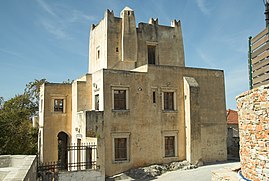
Kileler is a village and a municipality in the regional unit of Larissa in Greece. The seat of the municipality is in Nikaia. The village became known for the Kileler incident that occurred on March 6, 1910.

Schoinoussa or Schinoussa is an island and a former community in the Cyclades, Greece. Since the 2011 local government reform it is part of the municipality Naxos and Lesser Cyclades, of which it is a municipal unit. It lies south of the island of Naxos, in the Lesser Cyclades group, between the island communities of Irakleia and Koufonisia. The population was 229 inhabitants at the 2021 census. Its land area is 8.512 square kilometres (3.29 sq mi).

Tamyneoi is a former municipality of the island of Euboea, Greece. Since the 2011 local government reform it is part of the municipality Kymi-Aliveri, of which it is a municipal unit. The municipal unit has an area of 203.971 km2. The seat of the municipality was in Aliveri. The name reflects that of the ancient city of Tamynae.

Skiritida is a former municipality in Arcadia, Peloponnese, Greece. It was formed at the 1997 Kapodistrias reform; the seat of the municipality was in Vlachokerasia. Since the 2011 local government reform it is part of the municipality Tripoli, of which it is a municipal unit. The municipal unit has an area of 186.164 km2. It had a population of 930 at the 2021 census.

Oreoi is a village and a former municipality in Euboea, Greece. It was named after the ancient town of Oreus. Since the 2011 local government reform, it is part of the municipality Istiaia-Aidipsos, of which it is a municipal unit. The municipal unit has an area of 49.913 km2 and population of 2,827 (2021). It is situated on the northwest coast of the island Euboea, by the Oreoi Strait that connects the Aegean Sea with the North Euboean Gulf. The small port Agiokampos, 5 km west of Oreoi, is served by ferries to Glyfa on the mainland.

Irakleia or Heraklia is an island and a former community in the Cyclades, Greece. Since the 2011 local government reform it is part of the municipality Naxos and Lesser Cyclades, of which it is a municipal unit. Its population was officially 148 inhabitants at the 2021 census, and its land area 17.795 square kilometres (6.9 sq mi). It is a small island between the islands of Naxos and Ios. Close to Schoinoussa, Koufonisi, Donoussa, and Keros, together they form the Lesser Cyclades. The port is called Agios Georgios, while the "capital"/chora on the top of the island is called Panagia (Madonna). The biggest caves in the Cyclades are located on Irakleia. Irakleia can be reached by ferries from Athens, Naxos and Paros.

Thesprotiko is a village and a former municipality in the Preveza regional unit, Epirus, Greece. Since the 2011 local government reform it is part of the municipality Ziros, of which it is a municipal unit. The municipal unit has an area of 131.823 km2. The village was known as Lelova (Λέλοβα) until April 1, 1927 when it adopted its current name. An independent community since 1919, Thesprotiko became a municipality in 1948.
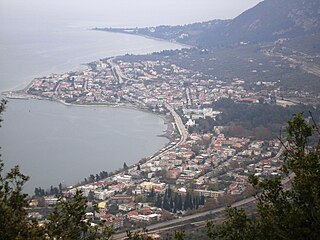
Kamena Vourla is a town and a municipality in Phthiotis, Greece. At the 2011 local government reform it became part of the municipality Molos-Agios Konstantinos, which was renamed to Kamena Vourla in July 2018. The population of the town proper was 2,796 at the 2011 census.
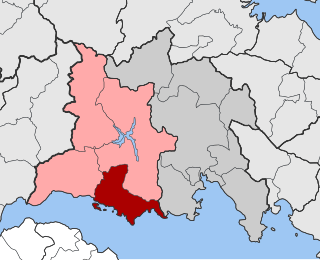
Tolofon is a village and a former municipality in Phocis, Greece. Since the 2011 local government reform it is part of the municipality Dorida, of which it is a municipal unit. The municipal unit has an area of 131.384 km2. The seat of the municipality was in Erateini. The ancient site of Tolophon is located in the northeastern part of the municipal unit. It is situated on the mountainous north coast of the Gulf of Corinth.

Kremasti is a town on the Greek island of Rhodes. Located on the west coast of the island, Kremasti is 12 kilometers from the capital of Rhodes, on the road to the airport. It has a population of 5,597 people and was the administrative center of the former municipality of Petaloudes.
Maza is a small village in the municipality of Apokoronas of the Chania regional unit on the island of Crete, Greece. At the time of the 2021 census, it had 104 residents. The village is perched on a mountain slope some 150 m above the valley of the Boutakas (Μπούτακας) river, 1.7 km to the south of the Chania-Rethymno road.

Neo Souli is a village in the municipality of Patras, Achaea, Greece. It is the main village of the community Souli, which consists of the villages Neo Souli, Agios Ioannis, Kefalovryso, Mintzaiika, Panagia and Profitis Ilias. Souli was part of the municipality of Patras between 1841 and 1912, and again after 1997. Between 1912 and 1997, it was an independent community.

Mavrochori is a village on the shores of Lake Orestiada in Kastoria regional unit of Macedonia, Greece.
Artemisia is a mountain village and a community in the municipality of Kalamata, Messenia, Greece. The community includes the small village Agios Ioannis Theologos. It is situated at 860 m above sea level. Many of its residents live there only during the summer months.
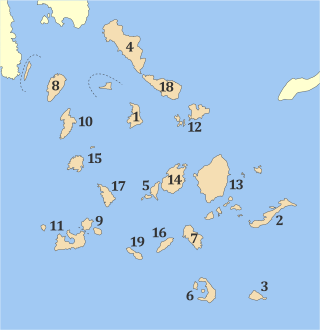
Naxos is one of the regional units of Greece. It is part of the region of South Aegean. The regional unit covers the islands of Naxos, Amorgos, Donousa, Irakleia, Schoinoussa, the Koufonisia islands and several smaller islands in the Aegean Sea.
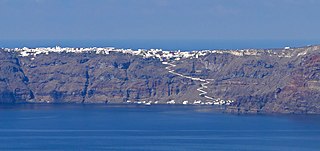
Manolas is the main settlement and the capital of Therasia, the small island opposite to Santorini (Thera). It is located in the east of island, above the abrupt Santorini caldera. It has a beautiful view of the volcano and the main settlements of Santorini such as Fira, Imerovigli, Oia, etc. Manolas can be approached either by road from the port of Riva or the uphill path from the small port of Korfos. Donkeys are the main mode of transport on this path. Manolas has a population of 140 inhabitants according to the 2021 census. It belongs to Thira municipality and Oia municipal unit.
Tsapournia is a village and a community of the Elassona municipality. Before the 2011 local government reform it was a part of the municipality of Sarantaporo, of which it was a municipal district. The community of Tsapournia covers an area of 27.197 km2.
Dimitritsi is a village in the region of Serres, northern Greece. According to the 2021 Greek census, the village had 633 inhabitants.
Rizovouni is a village and a community of Epirus in the municipality of Ziros in the Preveza regional unit. Its former name, Podogora, is of Slavic origin and means at the foot of the mountain. The late modern "Rizovouni" attributes to the Greek content of the Slavic word.
Grammatiko is a community in Pella regional unit, Macedonia, Greece. It consists of two villages: Kato Grammatiko and the smaller Ano Grammatiko.



